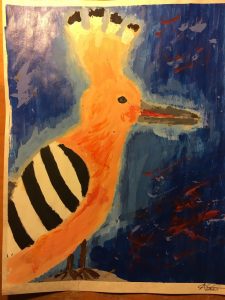
Religion is more than a set of ideological ideas used to separate individuals into groups in order to consolidate ideological power; it is also a personal journey one undertakes to better understand oneself and the universe around all of us. Viewing religion as a personal journey or set of practices used to embark on a journey for better self-understanding is prevalent in many religions including Islam. In our course, we saw religion as a personal journey represented in the story (and dance show) Conference of the Birds by Farid ud-Din Attar.
This story examines the journey of the Si Morgh (Thirty Birds) who travel to find the Simorgh, a wise and legendary bird. Motivating them to undertake this journey is Hoopoe a determined bird. At the beginning of the story, the birds all voice their hesitation on embarking on such a difficult path. Individual birds voice grievances that journey will be too mentally, physically, or emotionally hard, or that it is unnecessary for them to go upon such a journey. However, the Hoopoe strongly rejects their complaints with reason and wisdom. Eventually, the birds embark upon the journey and face different valleys of challenges that include Love, where one falls madly in love disregarding logic, and Detachment, where worldly possessions are abandoned. Eventually the birds realize that they, the Si Morgh are the Simorgh evoking the idea that the power of transformation and the final destination of this spiritual journey is within ourselves.
Hoopoe is a portrait painting of the brave bird from the Conference of the Birds, an epic poem by Farid ud-Din Attar. In a powerful speech the Hoopoe says to his fellow birds:
‘Your heart’s congealed like ice;
When will you free yourself from cowardice?
Since you have such a short time to live here,
What difference does it make? What should you fear?
The world is filth and sin, and homeless men
Must enter it and homeless leave again.
They die, as worms, in squalid pain; if we
Must perish in this quest, that, certainly,
Is better than a life of filth and grief.
If this great search is vain, if my belief
Is groundless, it is right that I should die.
So many errors throng the world – then why
Should we not risk this quest? To suffer blame
For love is better than a life of shame.
No one has reached this goal, so why appeal
To those whose blindness claims it is unreal?
I’d rather die deceived by dreams than give
My heart to home and trade and never live. (Attar lines 1732-69)
This quote along with Hoopoe’s refusal to grant any bird comfort in their excuse not to embark on their spiritual journey shows Hoopoe’s strength of faith. Hoopoe’s example reflects the importance of steadfast belief and passion in obtaining spiritual understanding. To portray this concept I painted Hoopoe as upfront with a watchful eye to portray Hoopoe’s strength and refusal to let the viewer visually escape into the darkness of the painting’s background. Hoopoe’s example reminds us of the importance of discipline in a spiritual walk which requires a strong will and also the ability to recognize the finite nature of life which helps one check their ego, an essential aspect of becoming one with Allah.
I was inspired to create this piece after speaking with Steve Coit, a portrait painter for the Harvard Foundation Portrait project. In this painting I tried to represent Hoopoe as a powerful and wise bird reflecting Hoopoe’s ability to lead the birds on their journey. To do this I painted the background dark blue which contrasts a hoopoe bird’s beige-orange color. The background is also not solid, but fades into Hoopoe, which provides depth to the painting making it more three dimensional. In the dark blue background representing the difficulty of their journey is the noise of other colors (red, orange, purple). This is meant to either represent the different valleys that make up the journey the birds undertake or could be the other birds. Like my other pieces, I wanted to add elements that allowed for subjective interpretation to make the painting more interesting. This is also meant to evoke the idea that we all have unique perspectives through which we view the world. Finally, I used a technique, Steve Coit taught me, which is to center Hoopoe’s eye in the portrait making Hoopoe the central subject who is looking off into the distance.
These ideas were examined during the Week 10 readings on The Conference of the Birds as well as the S. H. Nasr piece on Islamic art and spirituality.
Categories: